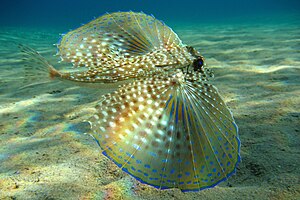Cocks
| Cocks | ||||||||||||
|---|---|---|---|---|---|---|---|---|---|---|---|---|

Dactylopterus volitans off the east coast of Crete |
||||||||||||
| Systematics | ||||||||||||
|
||||||||||||
| Scientific name of the subordination | ||||||||||||
| Dactylopteroidei | ||||||||||||
| Jordan , 1923 | ||||||||||||
| Scientific name of the family | ||||||||||||
| Dactylopteridae | ||||||||||||
| Gill , 1861 |
The flying cocks (Dactylopteridae, (gr.) Dactylos fingers, pteron wings, ptēnos feathered.) Are a family of real bony fish (Teleostei) consisting of two genera with seven species . Sea cocks live in the tropical Indo-Pacific , the Atlantic and the Mediterranean . Their characteristic feature are the large, wing-like pectoral fins , which they use for food acquisition (scaring), for courtship and for threatening. They certainly cannot fly with it - despite fantastic previous travel reports to the contrary, especially since they would have great difficulty ascending to the surface of the water (without a swim bladder ).
features
Head broad and square ("bone helmet" with keels and one long preopercular spine). Shield-like scales. Pectoral fins very widened and elongated; inner rays free (used for "walking"); a total of 28–37 rays. Two isolated dorsal spines in front of the (two) dorsal fins. Pectoral fins (VI / 4). No sideline organ . 22 vertebrae. There are no poison glands or fin spine furrows that evacuate secretions.
Systematics
Like the gurnard cocks (Triglidae), the flying cocks make growling, grunting noises when threatened. However, they are apparently not closely related to those, as the old (Cuviersche) order of the "Scleroparei" ( armored cheeks (Scorpaeniformes)) is in the process of dissolving and some researchers have long since placed the cocks in their own order, Dactylopteriformes . Lately, DNA comparisons speak for an assignment of the animals to the pipefish-like (Syngnathiformes).
species
There are seven known species in two genera.
-
Dactyloptena
- Dactyloptena gilberti , Snyder, 1909
- Dactyloptena macracantha (Bleeker, 1854)
- Dactyloptena orientalis (Cuvier, 1829)
- Dactyloptena papilio Ogilby, 1910
- Dactyloptena peterseni (Nyström, 1887)
- Dactyloptena tiltoni , Eschmeyer, 1997
-
Dactylopterus
- Dactylopterus volitans (Linnaeus, 1758)
literature
- Joseph S. Nelson : Fishes of the World , John Wiley & Sons, 2006, ISBN 0-471-25031-7 .
Individual evidence
- ^ William Leo Smith and Ward C. Wheeler: Polyphyly of the mail-cheeked fishes (Teleostei: Scorpaeniformes): evidence from mitochondrial and nuclear sequence data , Molecular Phylogenetics and Evolution Volume 32, Issue 2, August 2004, Pages 627-646, doi : 10.1016 / j.ympev.2004.02.006 .
- ↑ Ricardo Betancur-R, Edward O. Wiley, Gloria Arratia, Arturo Acero, Nicolas Bailly, Masaki Miya, Guillaume Lecointre and Guillermo Ortí: Phylogenetic classification of bony fishes . BMC Evolutionary Biology, BMC series - July 2017, DOI: 10.1186 / s12862-017-0958-3
- ^ Thomas J. Near, A. Dornburg, RI Eytan, BP Keck, WL Smith, KL Kuhn, JA Moore, SA Price, FT Burbrink, M. Friedman, and PC Wainwright. 2013. Phylogeny and tempo of diversification in the superradiation of spiny-rayed fishes. Proceedings of the National Academy of Sciences of the United States of America. 101: 12738-21743. doi: 10.1073 / pnas.1304661110 , PDF .